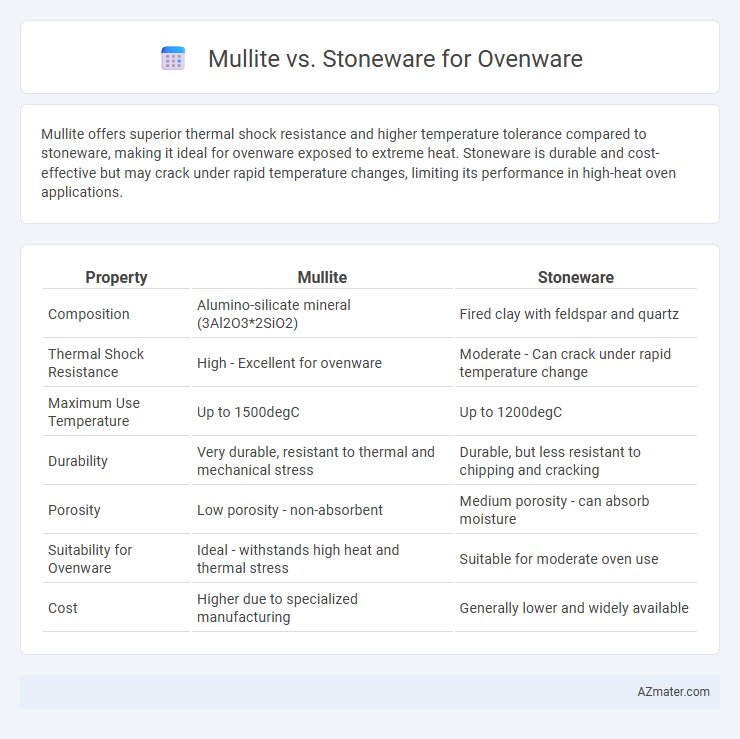Mullite offers superior thermal shock resistance and higher temperature tolerance compared to stoneware, making it ideal for ovenware exposed to extreme heat. Stoneware is durable and cost-effective but may crack under rapid temperature changes, limiting its performance in high-heat oven applications.
Table of Comparison
| Property | Mullite | Stoneware |
|---|---|---|
| Composition | Alumino-silicate mineral (3Al2O3*2SiO2) | Fired clay with feldspar and quartz |
| Thermal Shock Resistance | High - Excellent for ovenware | Moderate - Can crack under rapid temperature change |
| Maximum Use Temperature | Up to 1500degC | Up to 1200degC |
| Durability | Very durable, resistant to thermal and mechanical stress | Durable, but less resistant to chipping and cracking |
| Porosity | Low porosity - non-absorbent | Medium porosity - can absorb moisture |
| Suitability for Ovenware | Ideal - withstands high heat and thermal stress | Suitable for moderate oven use |
| Cost | Higher due to specialized manufacturing | Generally lower and widely available |
Introduction to Mullite and Stoneware
Mullite, a crystalline alumino-silicate mineral known for its exceptional thermal stability and resistance to thermal shock, is widely used in high-temperature ovenware applications. Stoneware, a dense, non-porous ceramic made from refined clay fired at high temperatures, offers excellent durability, heat retention, and resistance to chipping and cracking in everyday oven use. Comparing mullite and stoneware, mullite provides superior heat resistance for industrial or specialized ovenware, while stoneware balances practicality and reliability for household baking and cooking needs.
Composition and Material Properties
Mullite, a high-temperature aluminosilicate ceramic composed mainly of 3Al2O3*2SiO2, offers superior thermal shock resistance and low thermal expansion, making it ideal for ovenware exposed to rapid temperature changes. Stoneware consists primarily of fired clay with a mixture of quartz and feldspar, providing good durability and moderate heat retention but lower resistance to thermal shock compared to mullite. The higher alumina content and crystalline structure in mullite enhance its mechanical strength and thermal stability, outperforming traditional stoneware in high-heat baking applications.
Thermal Stability and Heat Resistance
Mullite exhibits superior thermal stability and heat resistance compared to stoneware, making it ideal for ovenware subjected to rapid temperature changes. Its high melting point around 1840degC and low thermal expansion minimize the risk of cracking during thermal cycling. Stoneware, while durable and heat-resistant up to approximately 1200degC, is more prone to thermal shock and slower to recover from temperature fluctuations.
Durability and Longevity
Mullite offers superior durability and thermal shock resistance compared to stoneware, making it ideal for ovenware exposed to rapid temperature changes. Its crystalline structure allows it to withstand high temperatures without cracking or warping, ensuring longevity in demanding kitchen environments. Stoneware, while durable, is more prone to chipping and thermal failure under extreme heat, reducing its lifespan in heavy oven use.
Performance in Oven Cooking
Mullite offers superior thermal stability and resistance to thermal shock, making it ideal for ovenware that requires rapid temperature changes and prolonged high heat exposure. Stoneware provides good heat retention and even cooking but is generally less resistant to sudden temperature fluctuations, which can lead to cracking. Performance-wise, mullite ovenware excels in durability and longevity during intensive oven cooking compared to traditional stoneware.
Weight and Handling
Mullite ovenware is known for its lightweight nature, providing easy handling and reduced strain during use, which makes it ideal for frequent transfers in and out of the oven. In contrast, stoneware is generally heavier and bulkier, offering greater stability but making it more cumbersome to handle, especially when hot or filled with food. The lighter weight of mullite contributes to improved maneuverability, while stoneware offers durability but at the cost of ease of handling.
Aesthetics and Design Options
Mullite offers a natural, earthy appearance with warm, muted tones ideal for rustic and artisanal ovenware designs, while stoneware provides a broader palette of vibrant glazes and smoother finishes suitable for modern and decorative kitchenware. The dense, glassy surface of stoneware allows for intricate patterns and glossy aesthetics that appeal to contemporary styles, whereas mullite's unique crystalline texture adds a distinctive, handcrafted charm to oven-to-table pieces. Both materials deliver durability, but stoneware's versatility in color and form makes it superior for varied aesthetic applications in ovenware design.
Health and Safety Considerations
Mullite, a high-temperature ceramic known for its exceptional thermal stability and non-toxic composition, offers superior health safety for ovenware by minimizing the risk of leaching harmful substances into food. Stoneware, while durable and often glazed for protection, may contain lead or cadmium in some glazes, posing potential health risks if improperly manufactured or used at high temperatures. Choosing ovenware made from certified food-safe Mullite ensures safer cooking environments by reducing chemical exposure and enhancing material integrity under intense heat.
Price and Value Comparison
Mullite ovenware offers superior thermal shock resistance and durability compared to stoneware but typically comes at a higher price point due to advanced manufacturing processes. Stoneware provides a more affordable option with good heat retention and aesthetic versatility, making it ideal for everyday cooking and baking. When evaluating price versus value, mullite is suited for high-performance uses requiring longevity, while stoneware offers cost-effective practicality for standard ovenware needs.
Choosing the Right Ovenware for Your Needs
Mullite ovenware offers exceptional thermal shock resistance and durability, making it ideal for high-temperature baking and frequent oven use. Stoneware provides excellent heat retention and even cooking but may be more prone to chipping and thermal shock. For heavy-duty, long-lasting ovenware, mullite is preferable, while stoneware suits everyday baking with moderate heat exposure.

Infographic: Mullite vs Stoneware for Ovenware
 azmater.com
azmater.com